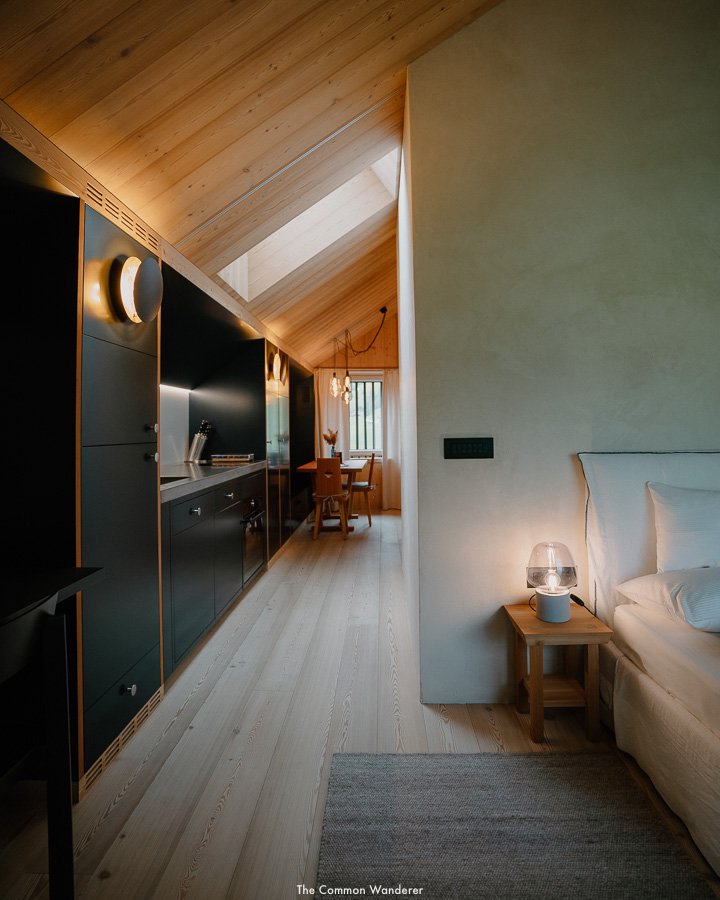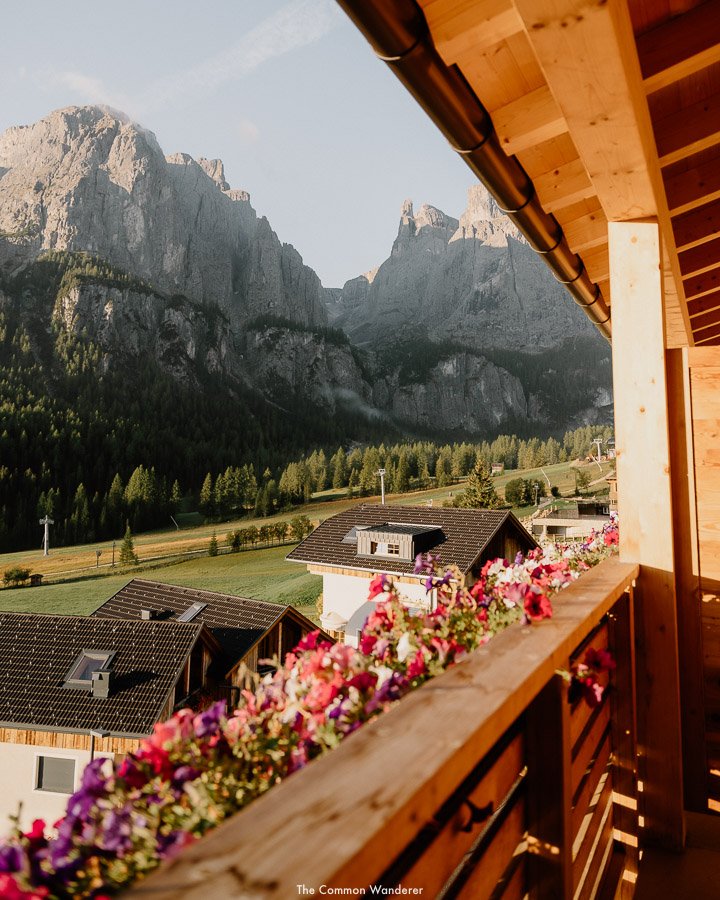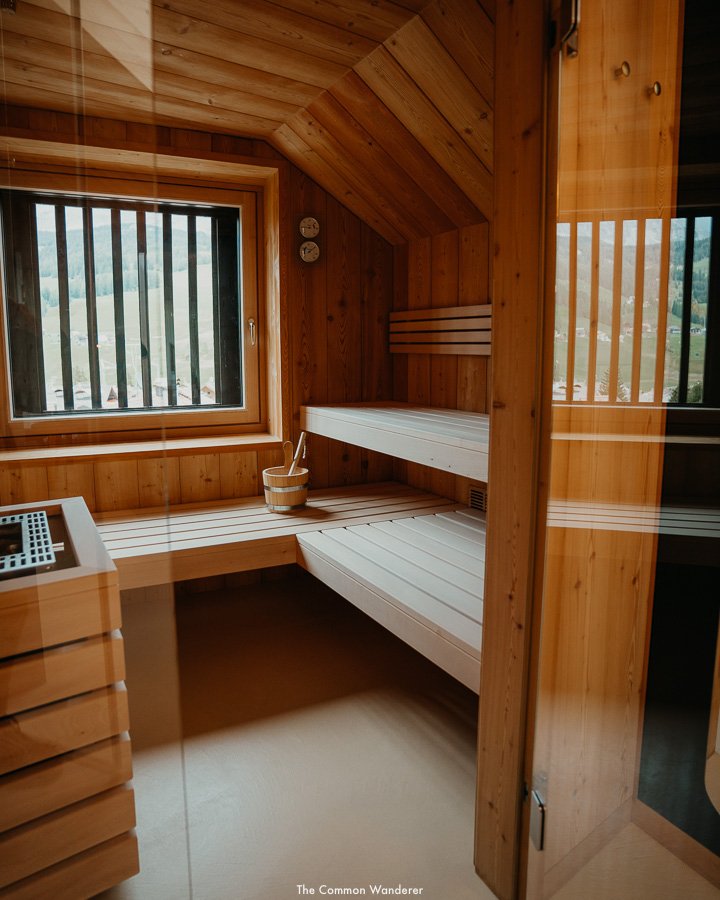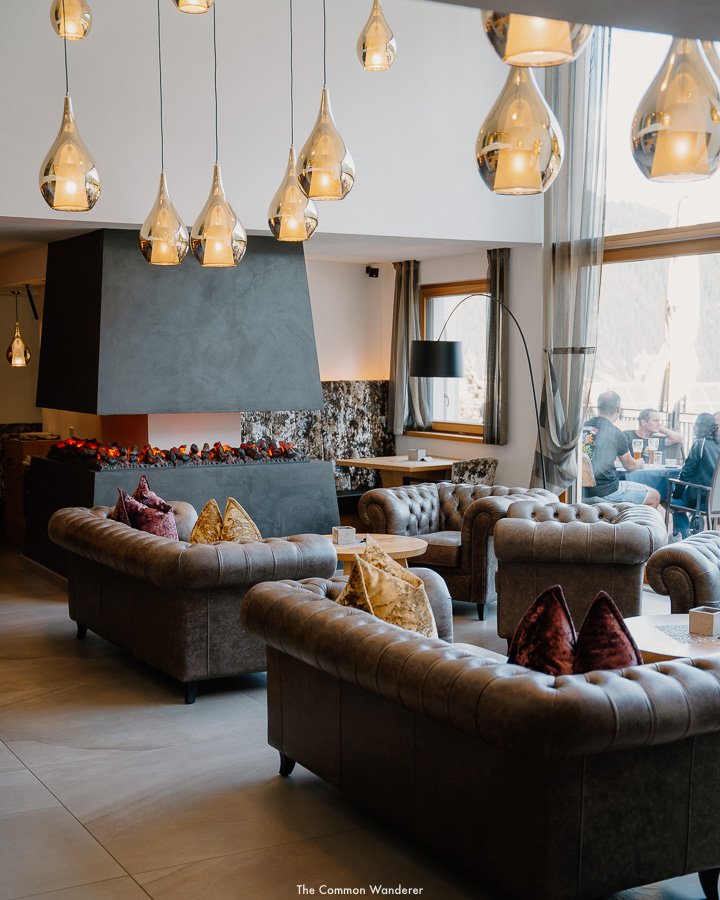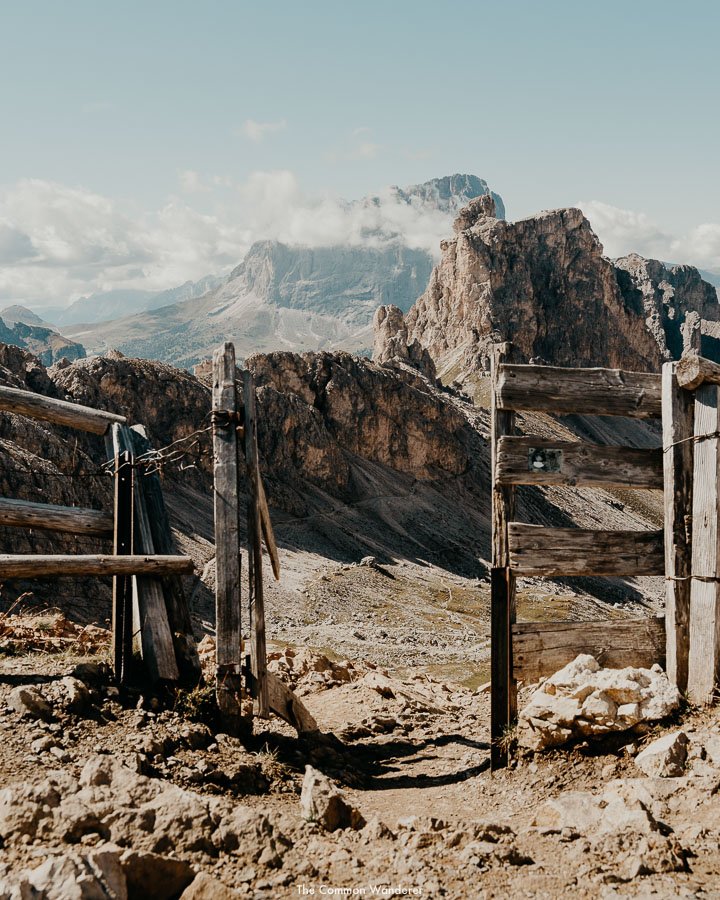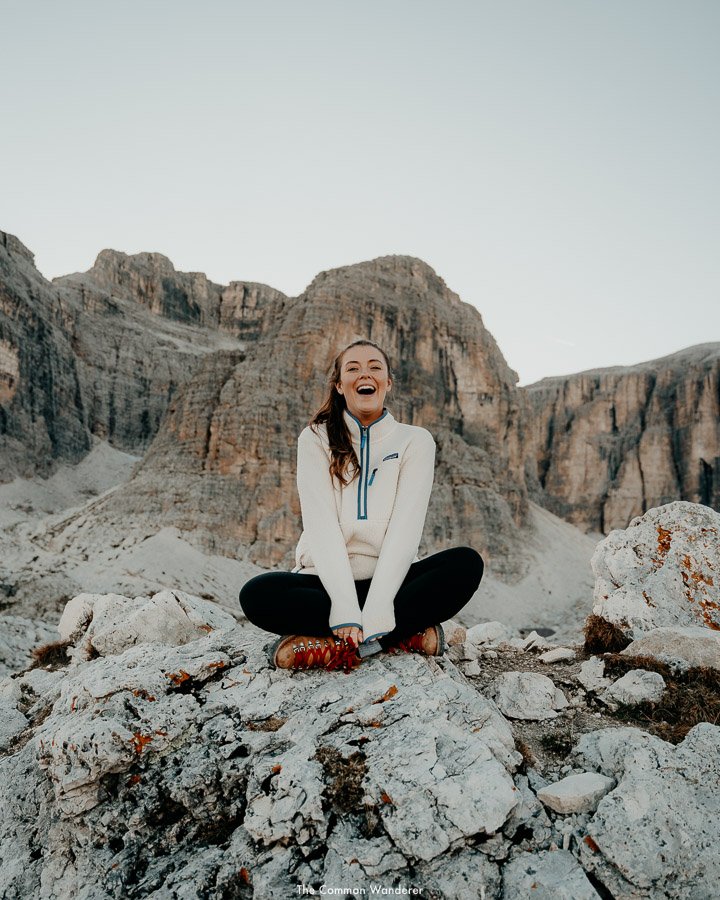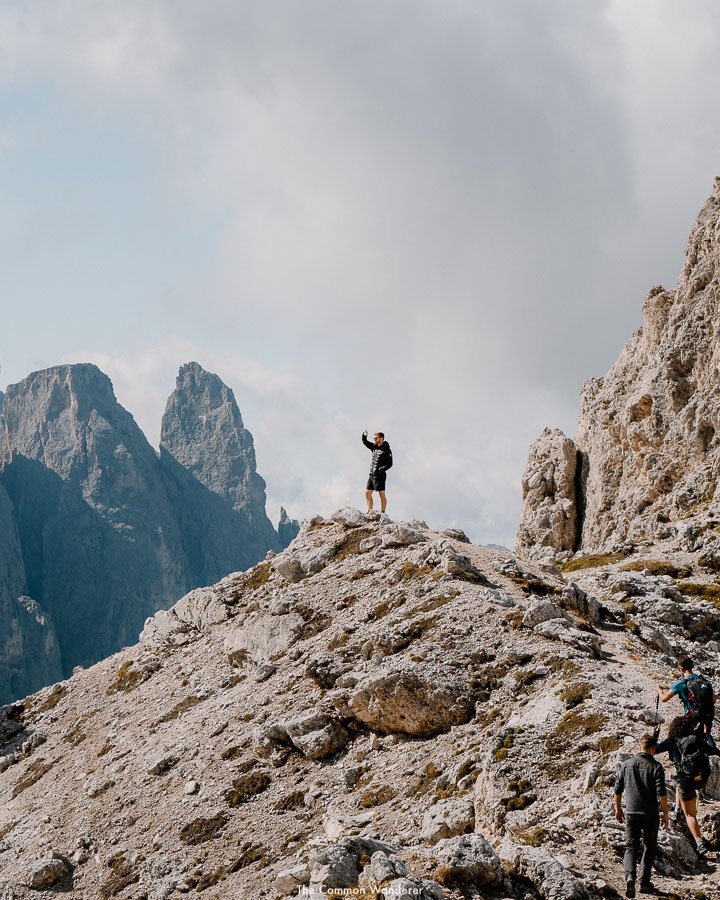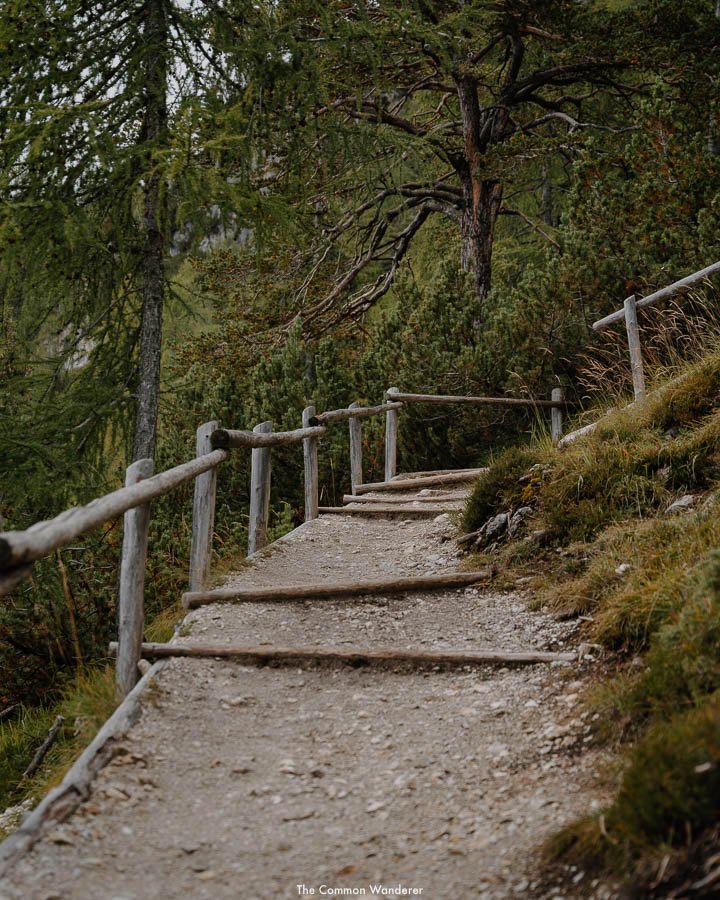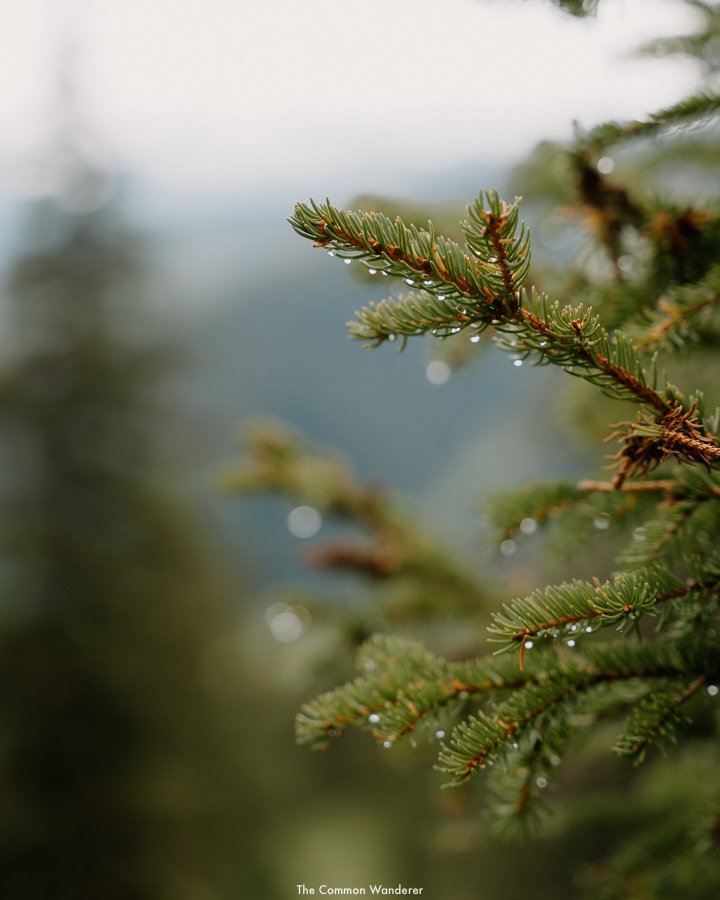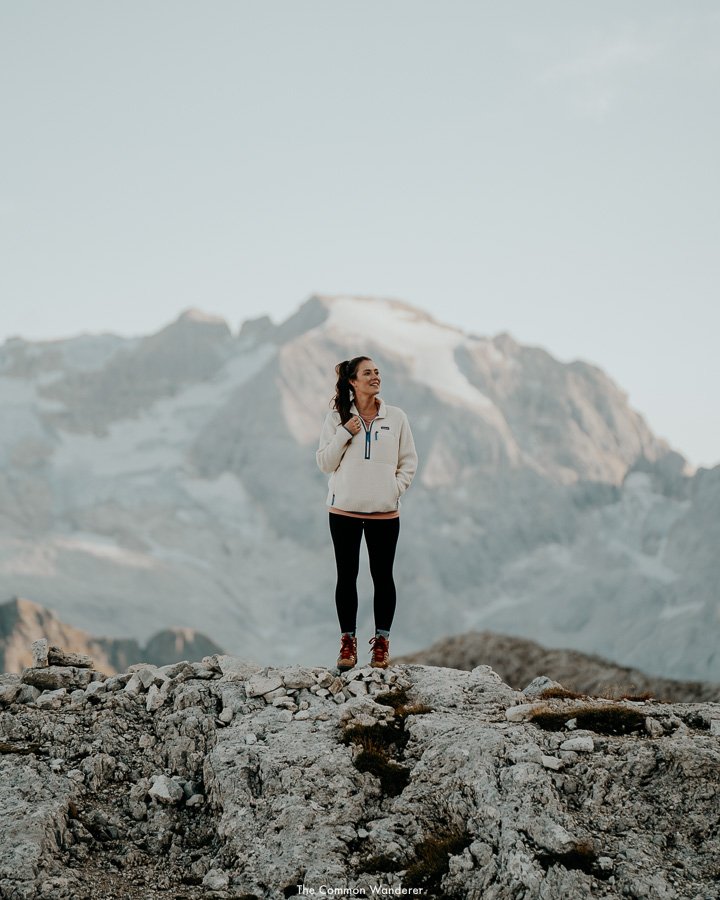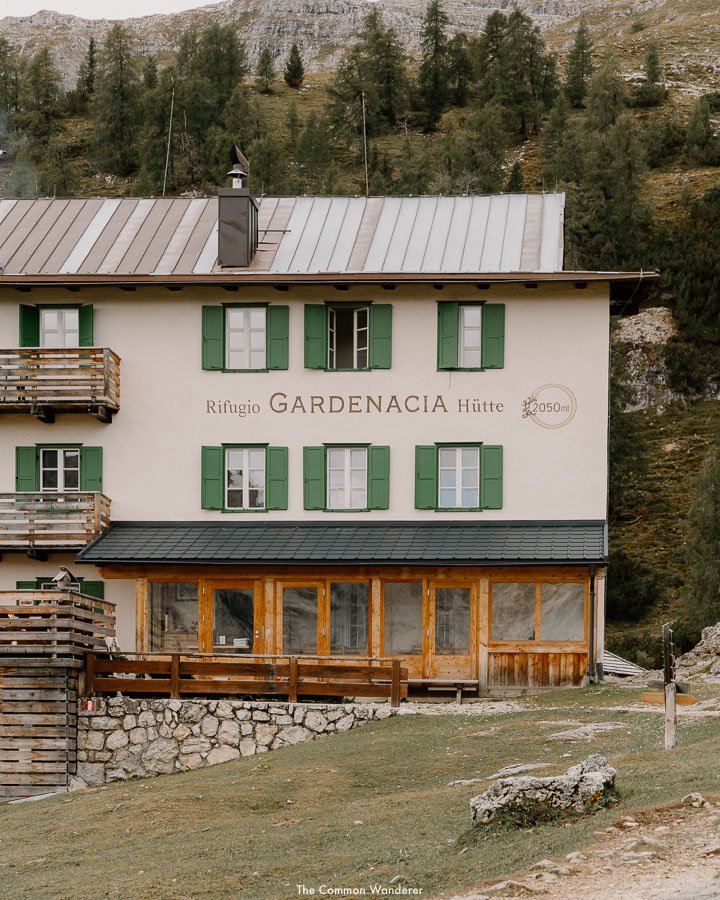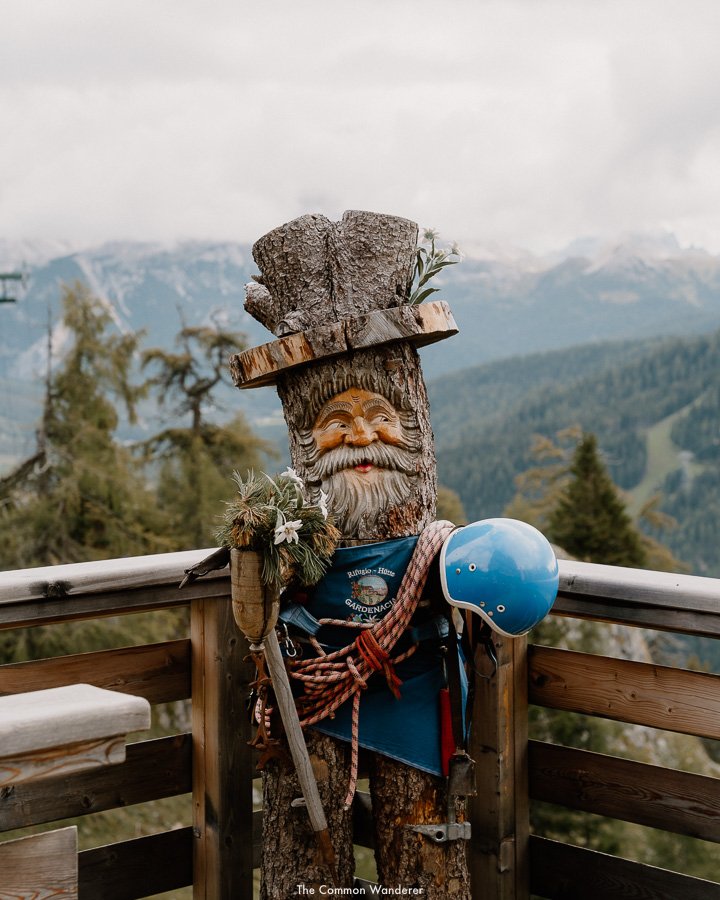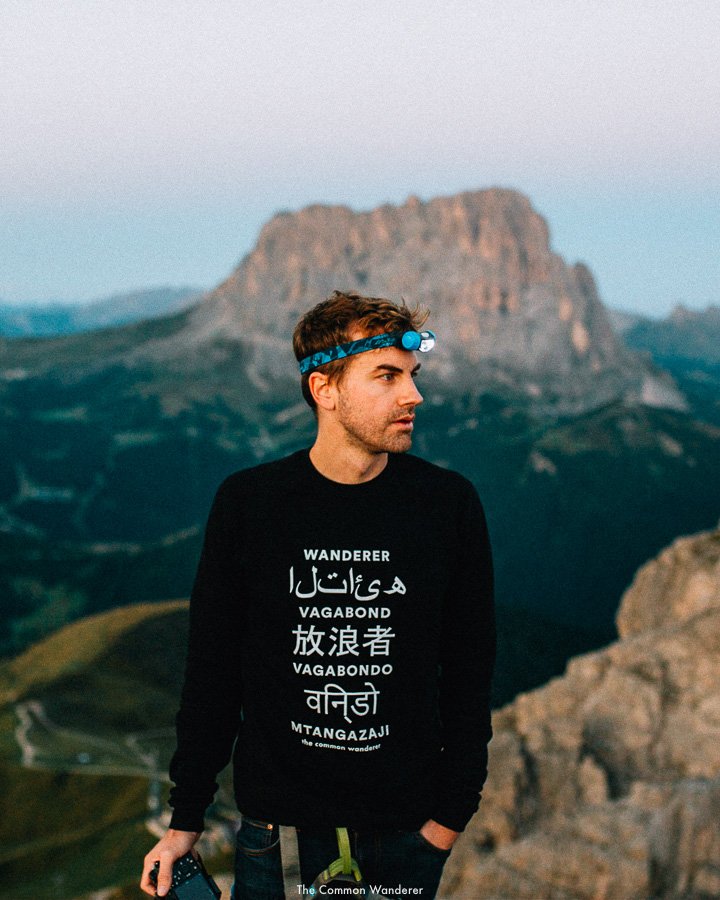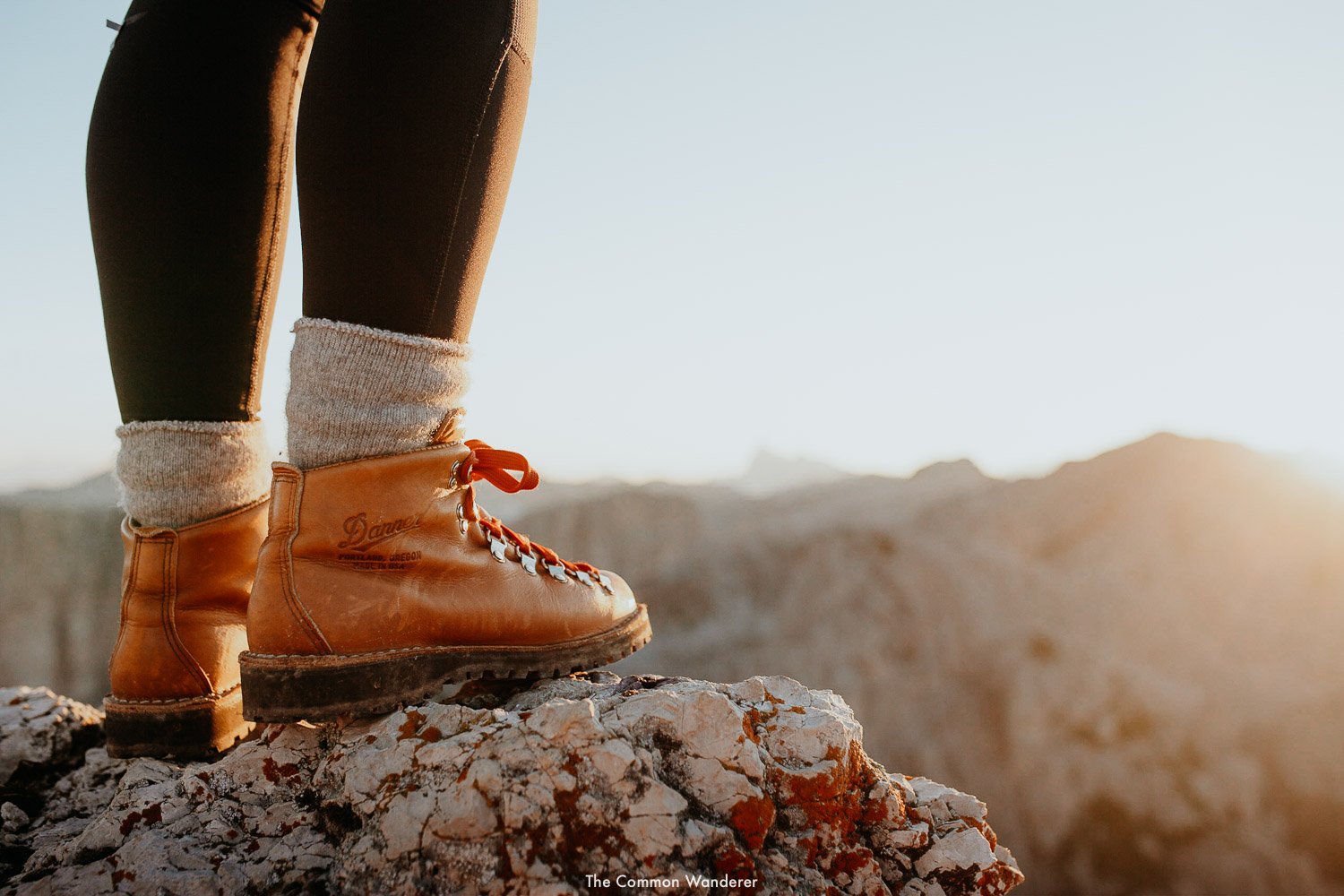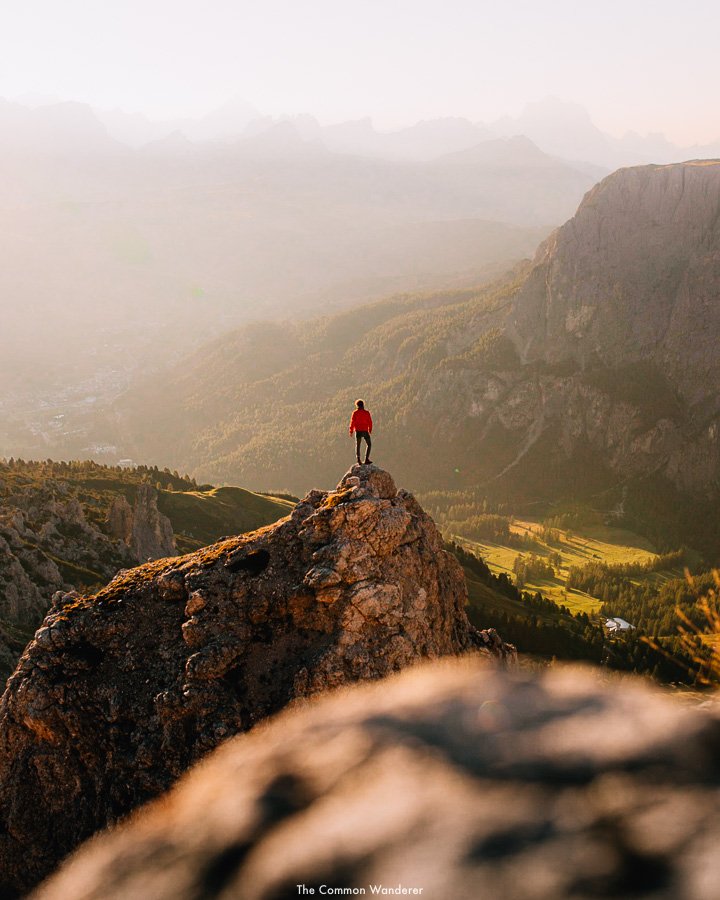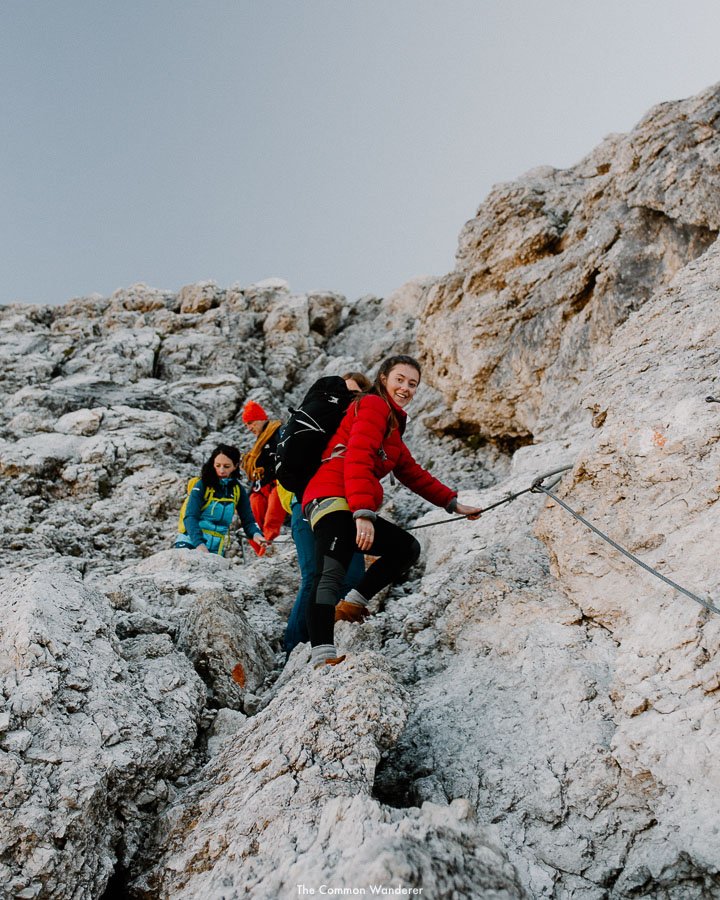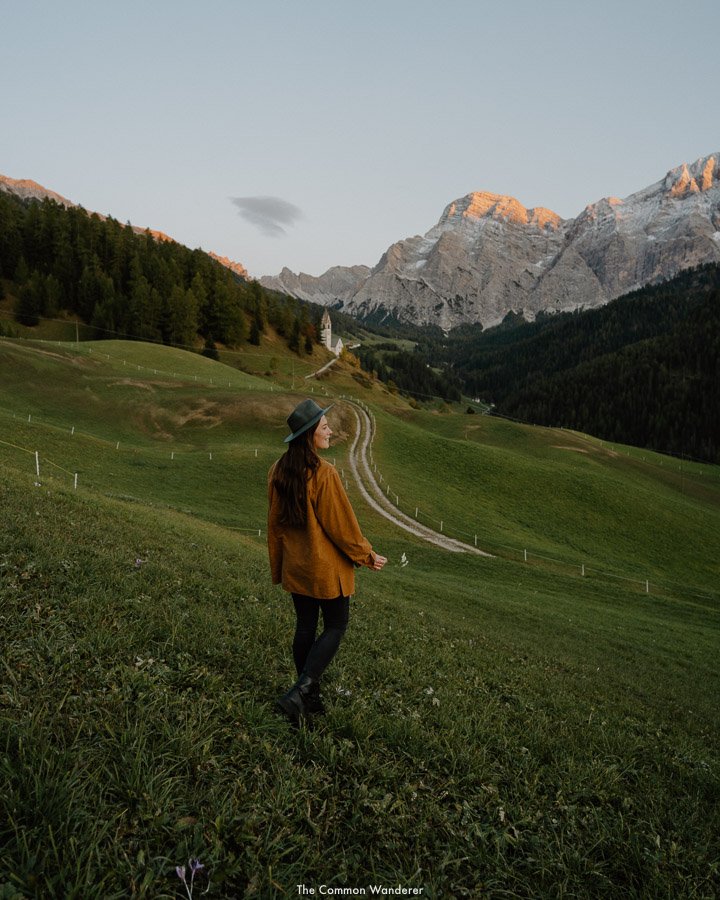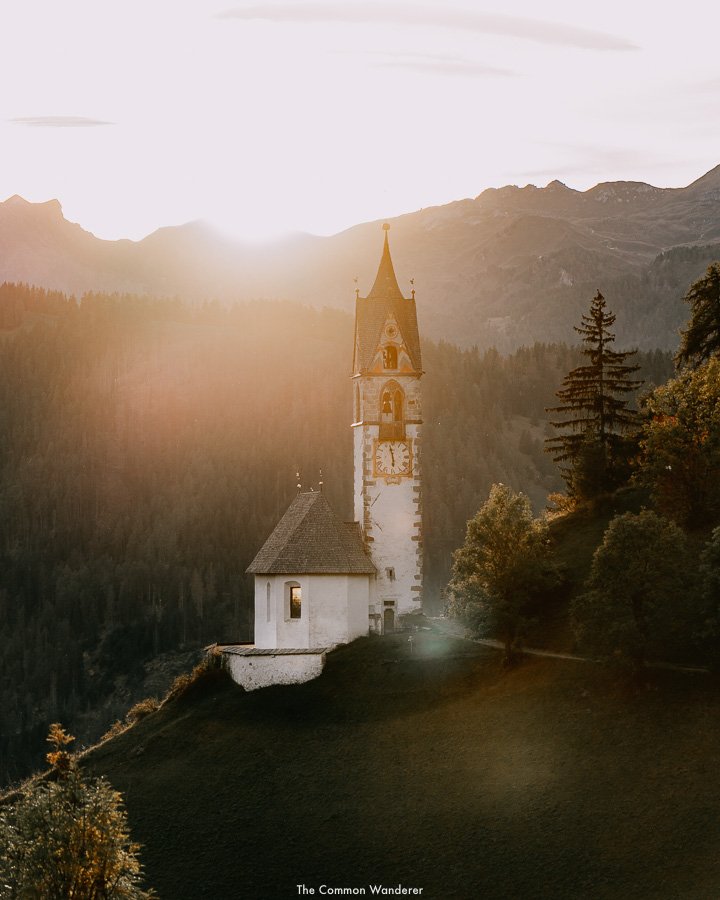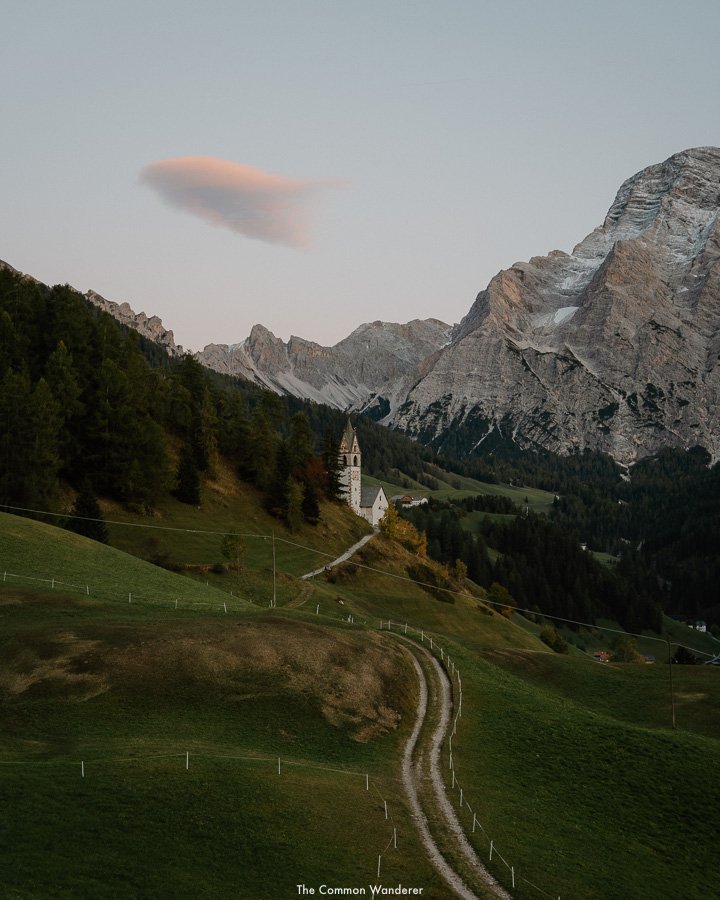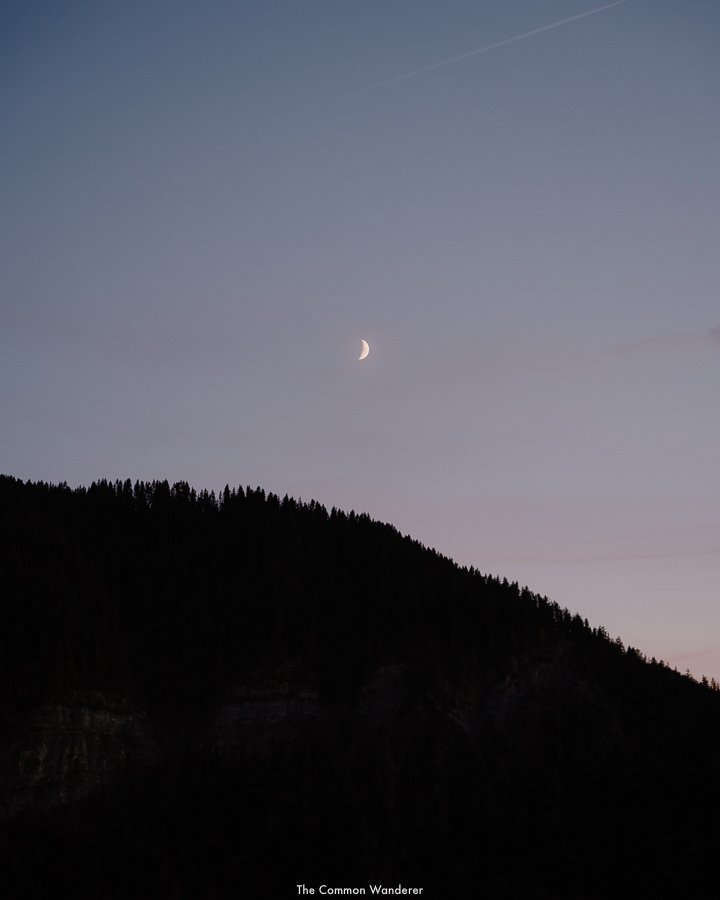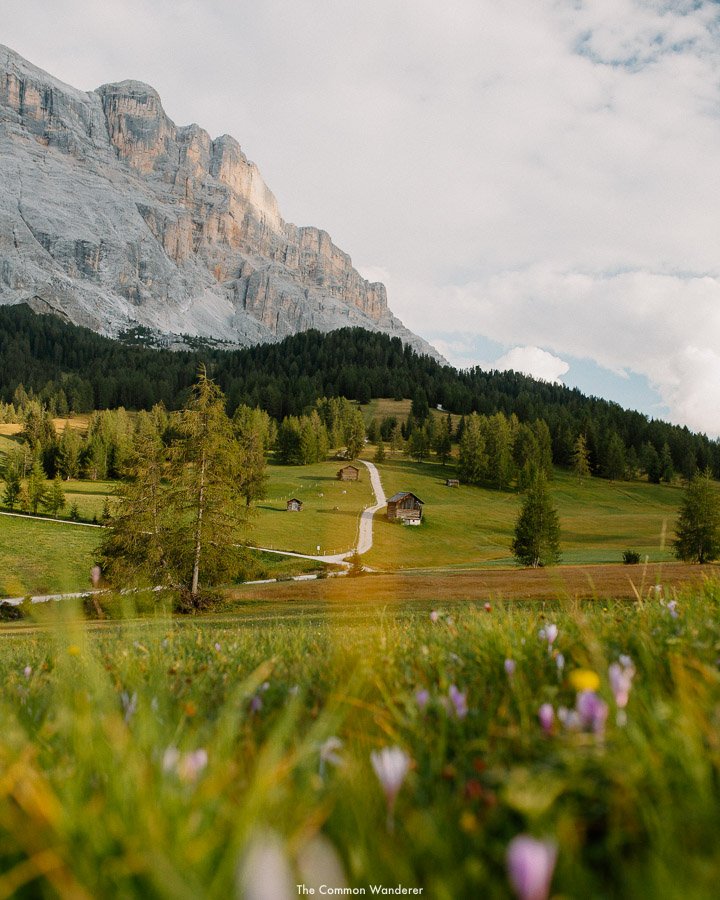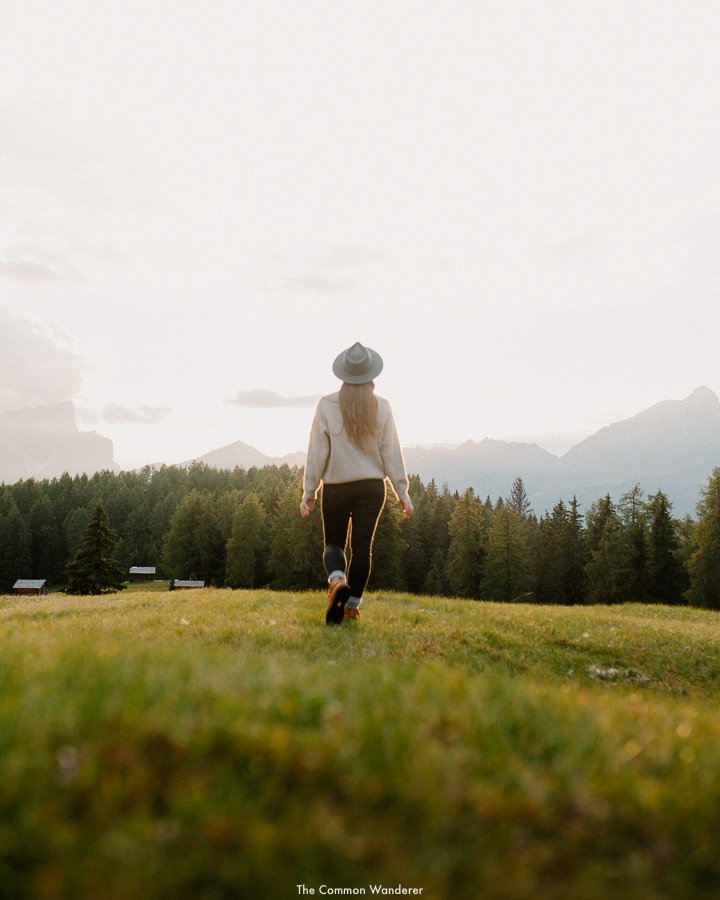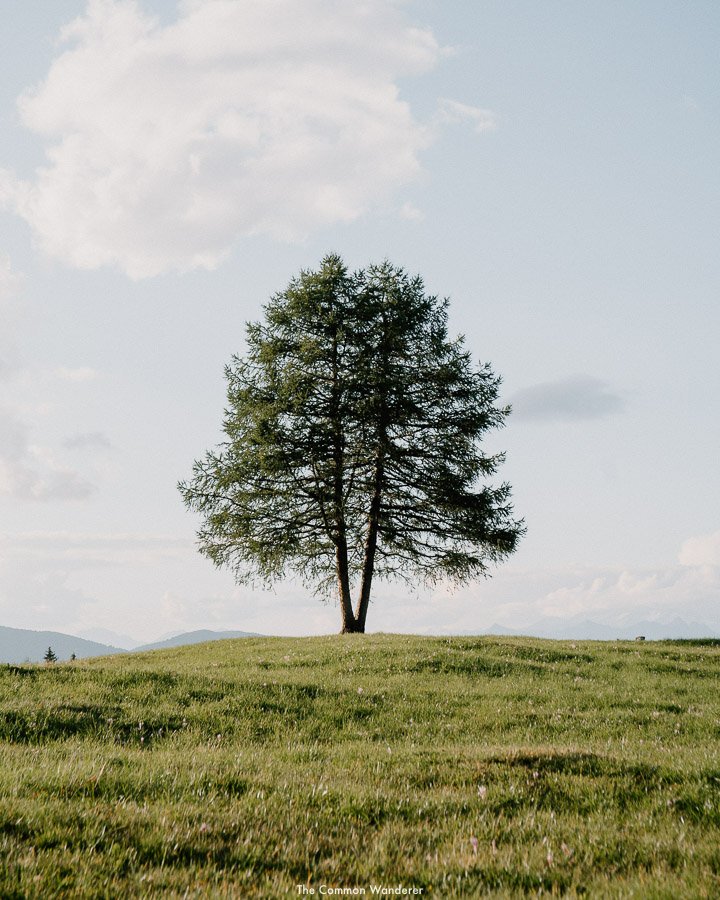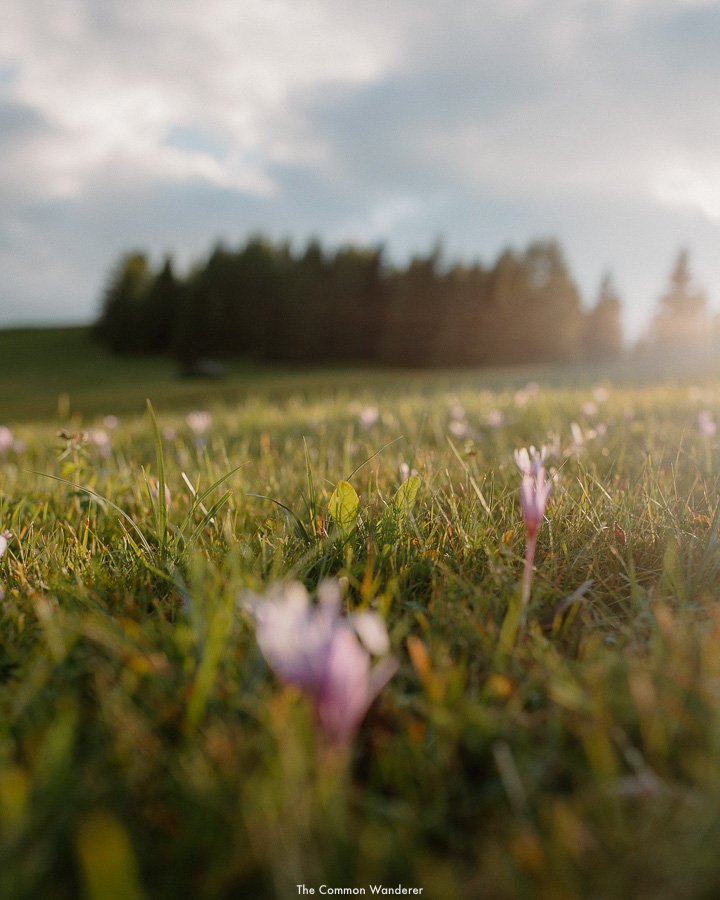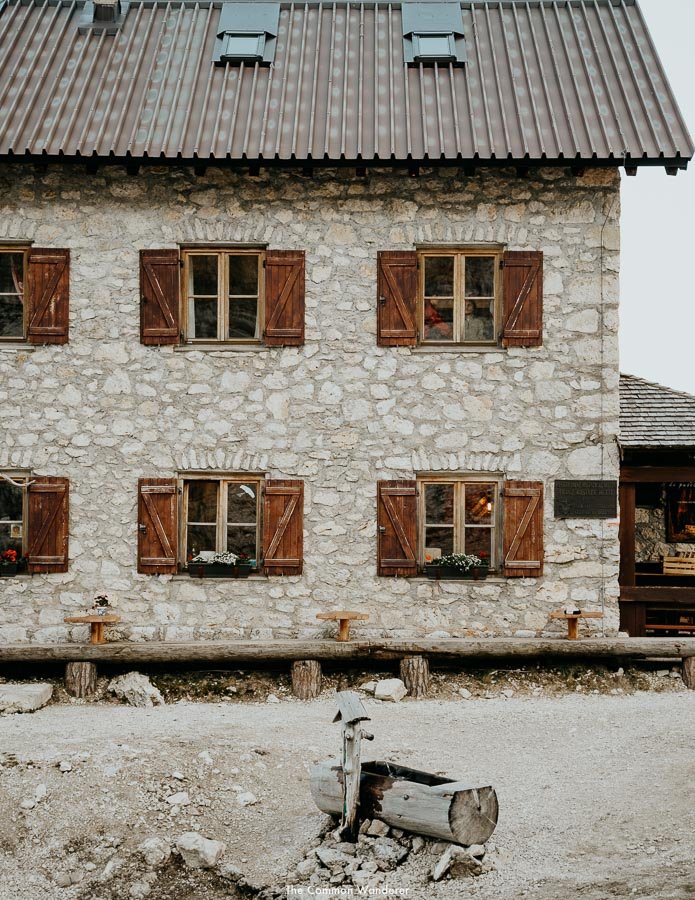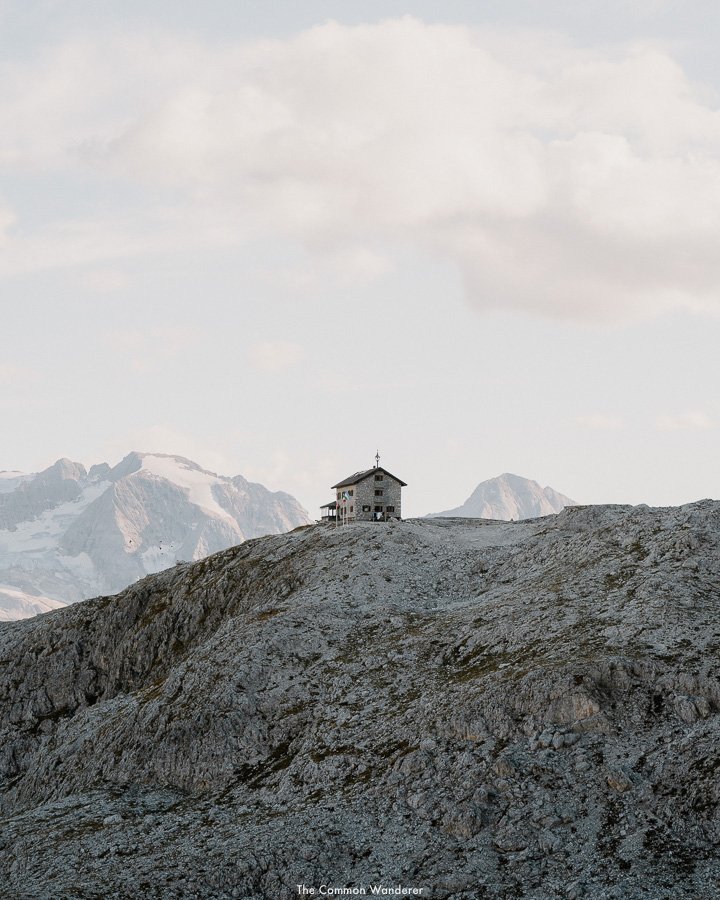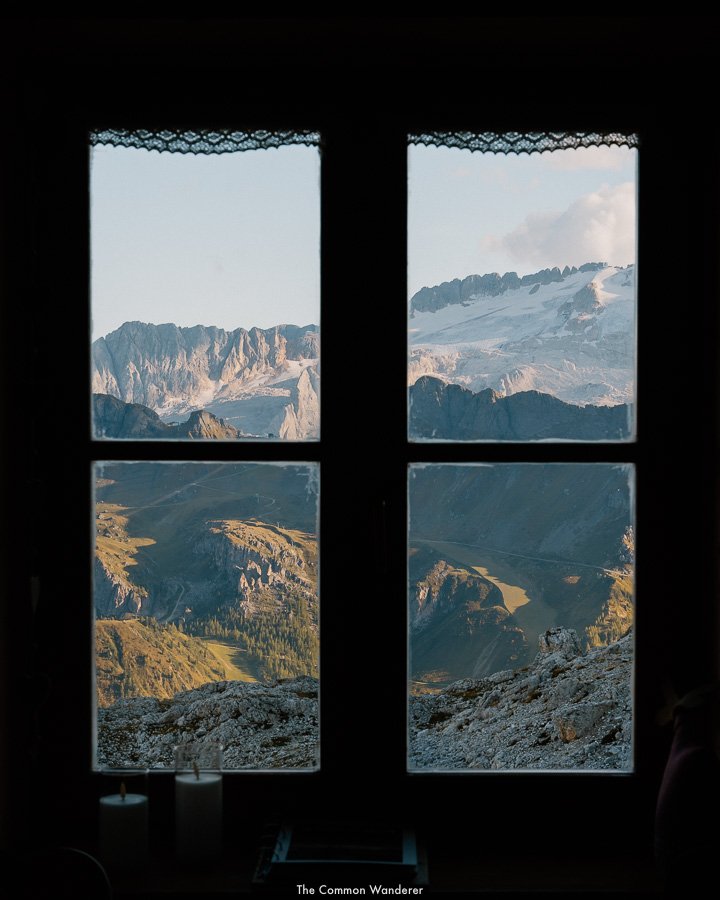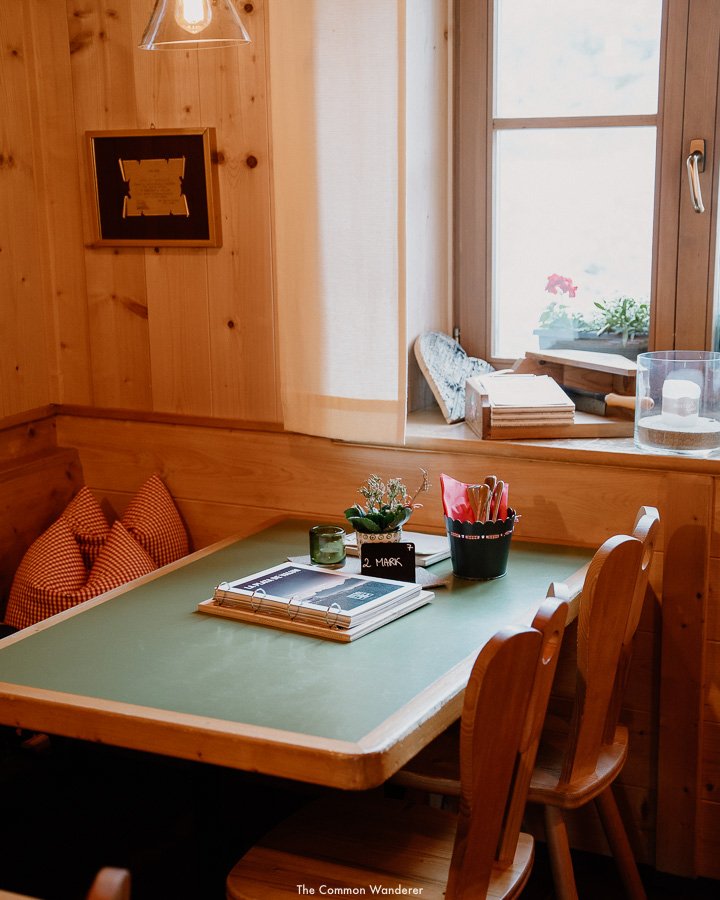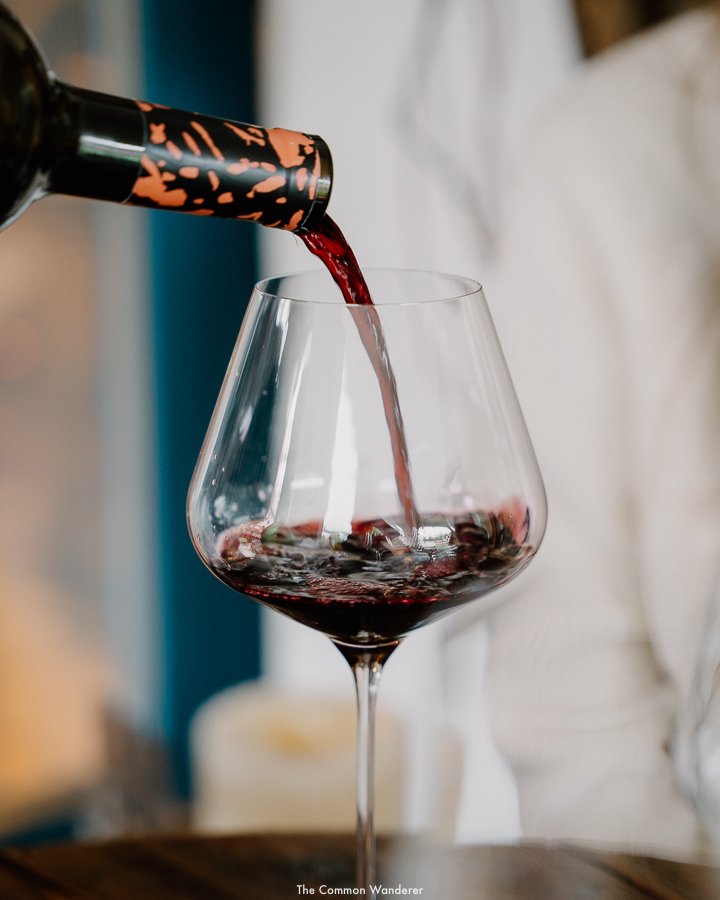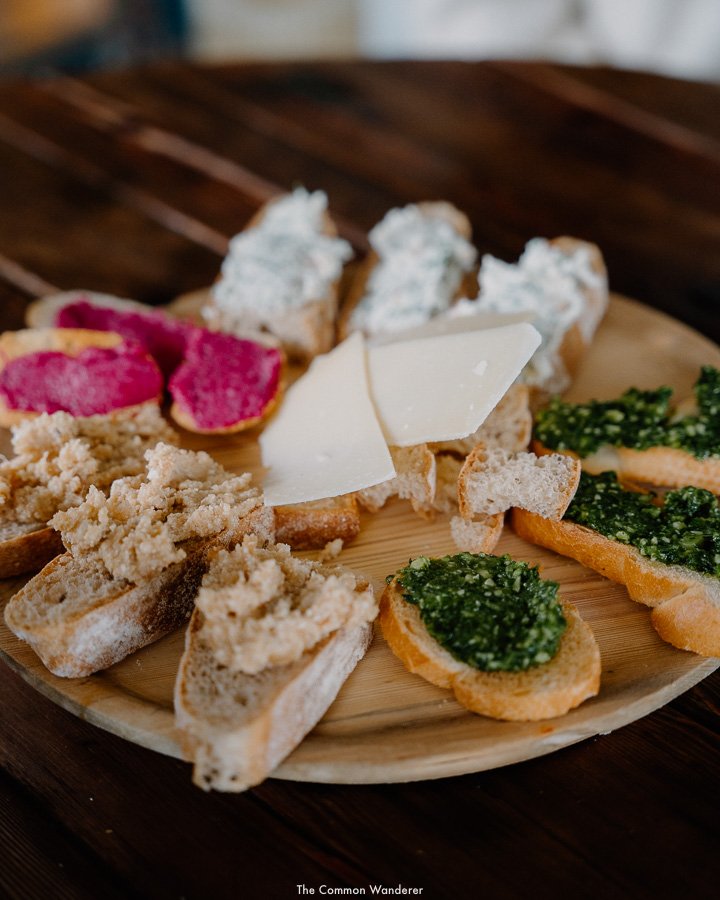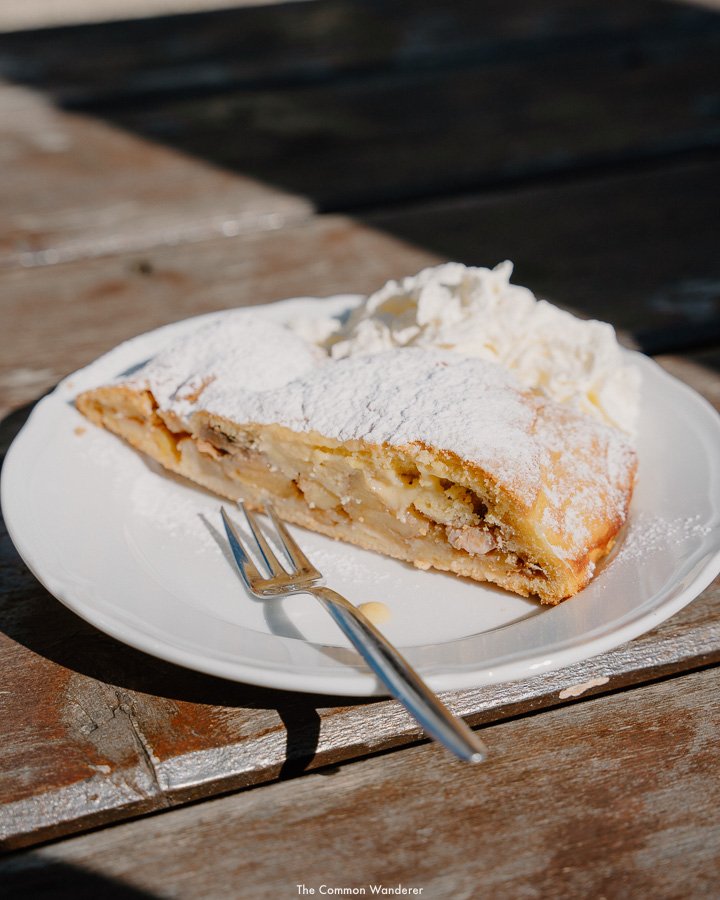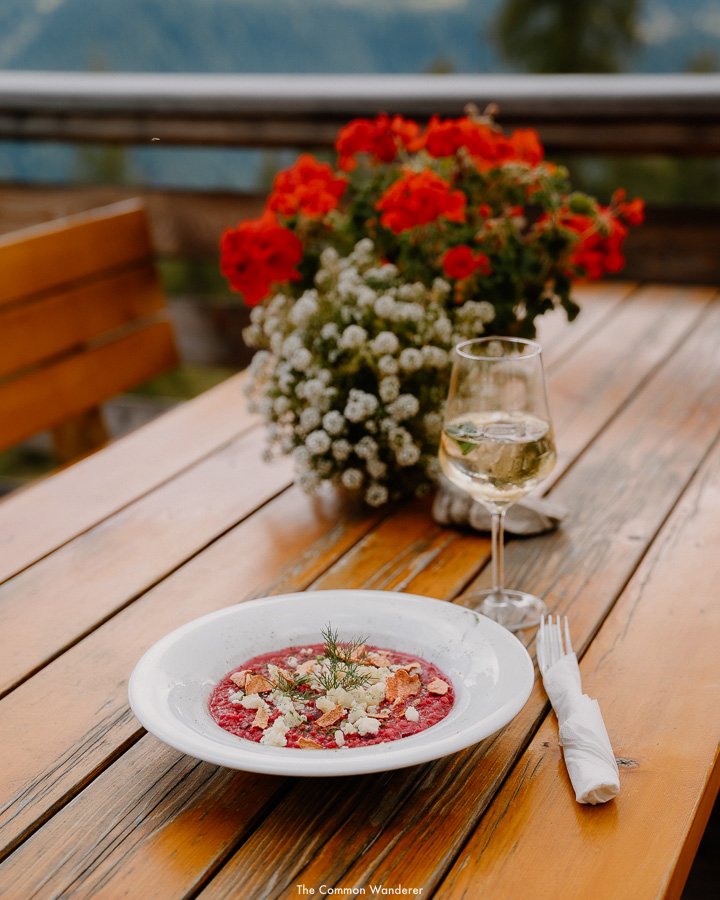A Guide to Summer in Alta Badia, South Tyrol: The Best Hikes, Food and Hotels
After five visits to Alta Badia in the Italian Dolomites, we’ve got to know this mountain paradise very well. Discover the best of Alta Badia with this guide, including what to see, the best restaurants, where to stay, and the most outstanding hikes.
Much like our own relationship, our love story with Alta Badia was a slow burn.
It started as lust in 2018 on our first trip to the Dolomites, a whirlwind tour of the major attractions in the region - sunrise from Gran Cir peak, a stroll through the colourful Armentara meadows, sunset at the achingly beautiful Chiesa Santa Barbara, and some outstanding food in between. It was a dopamine hit of pure, unadulterated, butterflies-in-the-stomach, love.
Then we came back - a second, third, fourth, and fifth time - peeling back the deep and pure layers and discovering a deeper love, one rooted in respect and admiration, not just wilful lust. We discovered the people, the culture, the hikes, and the regional food, and began to realise that Alta Badia is far more than its looks, it’s deep and beautiful on all levels, and impossible not to love.
Located right in the heart of the imposing Dolomites, and inhabited by the Ladin peoples, with their own language and mountain culture, things are different when compared to other parts of the Dolomites.
There’s a deep, mythological appreciation of the mountains and meadows, and you feel it when you visit - the unfamiliar greetings (hello = Bun dé, thank you = Giulan), the myths told on hikes and the appreciation of sunrise from a mountain peak.
It makes Alta Badia a wonderful and unique place to visit, especially in summer when the hills come alive.
This guide to Alta Badia runs through each corner of the pretty region, including what to see and do, the best hikes, where to stay, and most importantly, when to visit to enjoy its highlights. Prepare to fall in love.
Love our photos? They were all edited using our Europe Preset Pack, which you can purchase here!
ALTA BADIA SNAPSHOT
WHAT TO SEE | Passo Gardena, sunrise at Gran Cir peak, Armentara meadows, Santa Barbara Church
BEST HIKES | Crespeina lake - forecella Ciampëi, Gardenacia to rifugio Puez, Armentara Meadows hike
WHEN TO VISIT | Mid-June (spring), Mid-September - October (autumn)
WHERE TO STAY | Corvara, Colfosco, La Villa
WHERE IS ALTA BADIA
A picturesque, small, mountainous region punctuated by long, verdant meadows, quaint hamlets and jagged peaks, Alta Badia is situated in the heart of the South Tyrolean Dolomites in the north of Italy.
As part of the Dolomites UNESCO World Heritage site, Alta Badia runs from the southern part of Val Badia valley, approximately 40kms from the regional capital, Bozano. The main towns in Alta Badia include Corvara, Badia, La Villa and Colfosco.
The region is home to three official languages with over 97% of the population speaking Ladin, the local indigenous language, as well as German and Italian. Don’t stress though, English is very widely spoken, too.
WHEN IS THE BEST TIME TO VISIT ALTA BADIA?
Alta Badia, like most places in the Dolomites, gets super busy in the summer. Like, overflowing car parks, full hotels and annoying traffic type busy. So if you're like us, and like things a little quieter, the best time of year to visit Alta Badia is during September and early October.
If late summer isn't possible, spring is also a wonderful time to visit (mid-June - July), as wildflowers cover the meadows with bright bursts of colour, and snow still covers the upper mountains, providing the most picturesque backdrops to your explorations.
If you’re a winter lover, Alta Badia is home to some of the best ski runs in the Dolomites. We suggest visiting in late February / March when the slopes are quieter, but still filled with powder.
…
It’s important to note that the Alta Badia is a seasonal destination, and a lot of the towns and amenities (hotels, restaurants) shut down during the off-season, from mid-October - December, and between April - June.
This doesn’t mean you can’t visit the Dolomites during this period; it's just that you may struggle to find a full array of accommodation options, while gondolas, chairlifts and other transport won't be in operation.
READ | Our complete Dolomites guide
WHERE TO STAY IN ALTA BADIA
Alta Badia is a wonderful region to base yourself for all your summer adventures.
Centrally located, it’s close to all the major Dolomites attractions, summer hiking trails, excellent restaurants, and supermarkets if needed.
It also provides easy access to the breathtaking Passo Gardena; a high mountain pass full of hairpin bends connecting the valleys of Gardena and Badia.
Accommodation in the region can be quite expensive, so we recommend budgeting for a minimum of €100 per night.
Below are our top recommendations for accommodation in Alta Badia:
GARNI EDERA, CORVARA
We recommend staying at Garni Edera, a small, cheerful family-operated guesthouse just a few minutes’ walk from the Borest ski lifts.
The rooms are traditionally alpine in style, with wooden furnishings, mountain-view balconies, and private en suites. A hearty breakfast is also included in the bright kitchen area.
BOOK | GARNI EDERA
MOUNTAIN HOTEL MEZDI, COLFOSCO
The Mountain Hotel Mezdì was the first Dolomites hotel we ever stayed in (on our first trip to South Tyrol!), and it definitely set the standards pretty high for what to expect from an accommodation in the Dolomites.
A quintessential alpine chalet set in a quiet valley in Colfosco with traditional timber detailing, cute planter boxes full of pretty flowers, and epic mountain views from the floor-to-ceiling windows. The rooms are delightful too - warm, bright and inviting.
There are indoor and outdoor heated pools, plus a sauna and steam room to soothe your aching limbs after a long day on the slopes or hiking the trails, plus hearty mountain food and included breakfasts.
BOOK | MOUNTAIN HOTEL MEZDÌ
ROSA ALPINA HOTEL & SPA, SAN CASSIANO
Ever wondered where George Clooney sleeps when he visits the Dolomites? Well, wonder no more: in the pretty little mountain town of San Cassiano is where he finds his alpine dolce vita.
Rosa Alpina Hotel & Spa is a beautiful, family-owned hotel full of old-world charm, with plenty of nods to local Ladin traditions, from local antiques and wood detailing to frescoed walls.
Rosa Alpina is also the very lap of luxury, with not one but two spas, featuring indoor pools, a sauna and steam room, a gym, treatment rooms, and an adults-only sauna and hammam.
This is also the home of St Hubertus, the three Michelin-starred restaurant helmed by visionary head chef and local legend Norbert Niederkofler.
BOOK | ROSA ALPINA
CHALET D’ERT IN ALTA BADIA, LA VALLE
This beautiful three-bedroom guesthouse is located between Kronplatz and La Valle, which makes for the perfect skiing base in winter, and hiking base in summer. Giulia’s flat is a beautifully designed contemporary alpine chalet (and basically all our future home goals).
Surrounded by nature, the apartment is full of light and all the cosiness you need for your stay, while there are plenty of thoughtful touches (like books and board games) for your use during downtime.
BOOK | CHALET D’ERT IN LA VALLE
Alternatively, you can find more Corvara accommodation options here, San Cassiano accommodation options here, Colfosco accommodation options here
READ MORE | Looking for hotel recommendations in the Dolomites? Read our guide on where to stay in the Dolomites
WHAT TO DO IN ALTA BADIA
HIKE ALTA BADIA’S ENDLESS TRAILS
The Dolomites have some of the very best hikes in the world, and Alta Badia is the very epicentre of hiking in the region.
Waking before dawn to chase burnt orange sunrises from mountain summits, following ancient trails through hidden alpine meadows, and following rocky paths across moon-like landscapes, - and of course, enjoying delicious food in cute little mountain huts.
There are plenty of exceptional day walks (check out our guide to the best hikes in the Dolomites here) right through to full and multi-day hikes in Alta Badia - below are a few of our absolute favourites and the perfect starting point for your Alta Badia hiking adventures.
CRESPËINA LAKE - FORCELLA CIAMPËI PASSAGE HIKE
This is the perfect day hike for those wanting to experience the best of Alta Badia.
Starting from Passo Gardena, the hike (trail #2) slowly makes its way through the mountain pastures to Jimmi Hütte (where we totally recommend stopping for breakfast/coffee if you haven’t eaten already). From Jimmi Hütte, again follow trail #2 through the steep, craggy slopes for around 30 minutes, stopping to appreciate the Sella Group and Sassolungo as you gain elevation.
As the heart rate increases, the hike eventually levels out, passing through a rocky landscape that needs to be seen to be believed - an Avatar-like jungle of towering limestone spears and needles. It’s a short climb to Passo Cir, which provides some very epic views and is the perfect place for a water stop.
Follow the pathway down into the rocky valley towards Cristo del Crespeina, which again provides stunning views across Val Gardena towards Sassolungo and Alpe di Siusi. From here, Continue on trail #2, walking the endless lunar landscapes towards the stunning alpine lake of Lago di Crespeina, which is another wonderful place to stop and enjoy the surroundings.
From here, it’s a 30-minute walk to the Forcella Ciampëi passage, which provides stunning views back towards the Val Badia valley below. At this point, some like to continue on to the beautiful Rifugio Puez, however, we chose to take trail #4 back down through the Stella Alpina valley towards the picturesque Rifugio Edelweiss (Edelweiss Hütte).
This beautiful hut is home to delicious food, and on our visit, raucous mountain sing-alongs. It’s then a short, downhill walk into Colfosco to end the hike.
We recommend taking a bus to the trailhead and leaving your car at your accommodation, or in Colfosco.
HIKE DETAILS
Trailhead | Rifugio Frara / Passo Gardena Distance | 9km Duration | 5 hrs Difficulty | Moderate
ARMENTARA MEADOWS TRAIL
This is one of our favourite trails in Alta Badia, mostly because it’s fairly easy, but also because it’s super picturesque.
Starting in Badia, take the La Crusc chairlift to the stunning Rifugio Santa Croce, before commencing your hike on trail #15 through the towering larches that straddle the base of Sasso di Santa Croce.
The trail slowly winds its way through the forest before arriving at a rock clearing, where you can make a detour to the ice cave of Grotta della Neve (we suggest this as it’s super cool to see - just be careful to avoid rockfalls and ice melt).
From the cave, take trail #18 which descends through the forested part of the Armentara meadows, before arriving at the open plateau. We suggest stopping for lunch at Ranch da André, a quaint, and quite beautiful alpine hut, for lunch.
From Ranch da André you’ll soon arrive in the Armentara meadows proper. We think this is one of the most underrated and beautiful parts of the Dolomites - similar to Alpe di Siusi, yet with a 10th of the tourists. Take trail #15A back towards Santa Croce / La Crusc (1 hour), slowly meandering the meadows and taking in the stunning vistas.
Once back at Santa Croce / La Crusc, enjoy one of the best apple strudels you’ll ever eat at the rifugio, before ascending to Badia.
NOTE | If you wish to extend your hike, it’s possible to hike back down to Badia from Ranch da André - just take trail #7 all the way down
HIKE DETAILS
Trailhead | Rifugio Santa Croce / La Crusc Distance | 9km Duration | 3 hrs Difficulty | Easy
GARDENACIA TO RIFUGIO PUEZ
Taking in the picturesque Gardenacia hut and plateau, as well as the moon-like landscapes on top of the Puez-Odle Nature Park, the Gardenacia to Rifugio Puez hike is a must when in Alta Badia.
Starting in La Villa, take the Gardenacia cable car before commencing the hike, taking trail #5 to your right. It’s a steep, 40-minute hike to Gardenacia hut, where a coffee or strudel break is called for (or an early schnapps?!), before the real hike starts.
From Gardenacia hut, take trail #5 towards rifugio Puez, which ascends towards the Gardenacia plateau and the famous Alta Badia symbol, Sassongher ahead. The sweeping views of the Fanes mountains are stunning, so make sure you stop for a few photos before continuing your hike.
After an hour or so, the trail veers towards the right (trail #11, and then #15), and through the rocky Gardenacia plateau towards Forcella de Gardenacia. From here, it’s an hour-long hike through the epic high alpine landscapes that adorn the Puez-Odle Nature park to rifugio Puez.
Puez hütte may not be the best mountain hut in the region, but it’s a perfect place to stop and refuel before continuing your hike.
There are two ways to do this - either follow trail #4 towards Forcella di Ciampëi and the Edelweiss hut to Colfosco or take trail #1 back towards Gardenacia hut.
Alternatively, do the trek in reverse, and start hiking in Colfosco, ending at Gardnacia - this option would suit those wishing to stay in a rifugio, and enjoy some of the best food and mountain spritz in the region.
HIKE DETAILS
Trailhead | Gardencia gondola / Colfosco Distance | 13 km Duration | 7 hrs Difficulty | Moderate
NOTE | You can download the Alta Badia hiking map here
ALTA BADIA HIKING TIPS
Hiking in this part of the world can be a little confusing at first, especially in regards to parking, transport in the region, and food & drink options.
Here are our top Alta Badia hiking tips:
Purchase a Summer Lift Pass to access the 19 cable cars/gondolas in the region (€39 per day, €59 for 3 days). They’ll be your best friend, trust us
There are buses that service parts of Alta Badia which can help you get to certain trailheads. Buses depart regularly from major towns including Corvara, La Villa, and Badia. there’s also a free bus service that operates between Corvara and Colfosco every 30 minutes
Bring a reusable water bottle. Purchase a water filtration + purification bottle (like our faves from The Grayl) and you will literally never need to purchase bottled water again
Alta Badia trails can get extremely busy in the height of summer, so we suggest trekking either side of the peak periods to avoid contributing to over-tourism and environmental degradation
It’s also a good idea to arrive early in the day to avoid crowds, which in our opinion makes the experience far better
Whatever you do, don’t litter in this pristine natural environment. Where you can, avoid plastic altogether on your trek, and if you can’t, carry it out of the national park with you
Pick up any trash you see. Although there’s not much rubbish on the Alta Badia, the odd piece can be found. If you come across rubbish on your trek, collect it in a tote bag and take it off the trails with you to dispose of properly later
TAKE A DRIVE OVER PASSO GARDENA
There’s nothing better than slowly winding your way along an edge-of-your-seat mountain roads and hairpins, encased by large trees and ever-larger mountains, overlooking the slowly shrinking valleys below, with your favourite road trip tunes pumping.
If you’re planning a road trip through the Alta Badia and the Dolomites, then you’ll surely want to tackle some of the incredible mountain passes scattered throughout the region, including the most popular, Passo Gardena.
Connecting the Val Badia and Val Gardena valleys, the pass is not only incredible (especially at sunrise or sunset), but is also a great starting point for a number of incredible hikes and via ferrata, including the wonderful Gran Cir peak.
During autumn, the surrounding larches turn a wonderful shade of yellow/orange, making a drive through here even more delicious.
It really is a feast for the eyes, and we recommend stopping at the top to take in the surrounding vistas, especially if you so happen to pass during sunset.
VIA FERRATA ON GRAN CIR FOR SUNRISE (OR SUNSET)
In order to really feel Ladin, you must reach the top of a mountain in the Alta Badia and admire the sunrise from there. And the best way to do this is by via Ferrata.
What’s a via ferrata (roughly translated to iron path in Italian), we hear you ask?
It’s basically a protected climbing route, which uses steel cables, rungs, or ladders, fixed to the rock to allow climbers to safely ascend and descend with a harness if needed. It’s similar to rock climbing, but hikers can complete one without the technical knowledge and know-how.
…
On one glorious autumn morning, we got to experience a via ferrata to the summit of Gran Cir for sunrise. Sure, it was an easy introduction to a via ferrata, but the experience was no less exhilarating.
Starting from Passo Gardena (Rifugio Frara), we made our way up a steep scree gully towards the summit. It was pitch dark, save for the headlamps which shone brightly amongst our fellow climbers.
From there, it was a slow and steady mix of hiking, scrambling and rock climbing, punctuated by breaks in which to catch our breath on this steep ascent in horribly humid weather. Despite the early wake-up, the rush of adrenaline as we reached the summit was immeasurable.
From the peak, the sunrise was truly spectacular - a 30-minute long show featuring mother natures most brilliant set of colours - from blue to purple, red to orange, culminating in the sun peaking over Cima Cunturines in the distance. From the peak, it’s possible to enjoy the 360-degree views of the Dolomites surrounding you, including the Sella Group, Sassolungo, and the Monte Antelao and Pelmo.
On the way down, we stopped in at JimmiHütte for a delicious South Tyrolean breakfast.
There are many via ferrata available throughout the Alta Badia region, including Piz da Lech (for another sunrise beauty) and ferrata les Cordes near Gardenacia.
THE DETAILS
WHERE | Rifugio Frara, start of Gran Cir hike
TIPS | Wear sturdy hiking boots, and bring a headlamp if summiting for sunrise
WATCH SUNSET AT CHIESA DI SANTA BARBARA (BARBARAKAPELLE)
Hidden away in the hills above La Val lies St. Barbara Church, one of the most beautiful, serene views in all of the Dolomites.
Constructed in the 15th century by miners of Valparola in honour of Santa Barbara, the patron saint of miners, the church itself is small, with historically important frescoes and paintings depicting the Crucifixion, as well as a range of internal murals.
However, the location, set on a panoramic hill with the peaks of the Puez-Odle national park searing behind, make it one of the most beautiful backdrops in all of the Dolomites.
Best viewed around sunset when the sun illuminates the church as well as the surrounding mountains in a gorgeous marmalade / pink glow.
It’s a 30-minute - 1-hour hike uphill from La Val, following the Memento Vivere pathway. Alternatively, drive through the tiny villages and winding roads to this car park, before walking to the church proper. We suggest hiking beyond the church and into the meadows for the most impressive views.
THE DETAILS
Where | Chiesa di Santa Barbara
LEARN ALL ABOUT LADIN CULTURE
Alta Badia is home to Ladin culture, a specific culture derived from Rhaetian people who have occupied these hills and valleys for millennia. Their unique language evolved from vulgar Latin spoken by the magistrates and soldiers at the time, and it gradually evolved into the Ladin language.
Ladin is rich in myth and legend, and its people have roots in mountain farming and craft work, which is evident throughout the region, and the language is spoken in both the Val Badia and Val Gardena valleys, by roughly 4 % (18,000) of the inhabitants. You can read all about Ladin culture here.
If you’re keen to learn more about the Ladin culture, make a visit to the Ladin Museum at Tor Castle, which has exhibitions on the geology, archaeology, history, language and handicrafts of the five Ladin-speaking valleys.
THE DETAILS
Where | Tor Castle, Alta Badia
Cost | €10
Opening Hours | Tues - Sat: 10 am - 5 pm, Sun: 2 pm - 6 pm
HIKE THROUGH THE STUNNING ARMENTARA MEADOWS
During our first visit to Alta Badia, we spent a late afternoon frolicking among wildflowers, mountain cabins and rolling pastures under the searing rock face of Sasso di Santa Croce. We ran from one side of the meadows to the other, photographing every which way as the sun began to set over the Puez-Odle mountains. At the time, we had no idea where we were, we just knew it was some kind of heaven (forgive us, we were on a job and hadn’t yet comprehended the significance of the Dolomites).
Years later, after speaking to a local friend, we found out that the place with the wildflowers and cabins and meadows was Armentara.
A hidden gem of Alta Badia, Armentara meadows are glorious. Home to over 200 species of wildflowers (buttercups, primroses, globe flowers, cranesbill, clover, orchids etc.), it’s a patchwork of bright colours as far as the eye can see.
It’s essentially a baby Alpe di Siusi, with fewer tourists and potentially more impressive vistas.
Best visited at sunset, we suggest making your way to La Crusc (Santa Croce) and hiking into the meadows (see our hiking guide above for more information), before enjoying the sunset amongst the wildflowers. Stop at Utia Ranch da André for an early evening meal and your day will be complete.
THE DETAILS
Where | Armentara Meadows
Read more | Our guide to Alpe di Siusi
STAY IN A RIFUGIO (MOUNTAIN CABIN)
Our first ever night in the Dolomites was spent in a rifugio. It was amazing. We ate hearty alpine food in a crowded dining hall, where laughter abound. We slept soundly, window open enjoying the fresh mountain air. And we rose early, just before sunrise, to experience the Dolomites at their most majestic.
Having enjoyed many a day and night in the teahouses of Nepal, we felt right at home (albeit with a few more home comforts than Nepali teahouses!), enjoying the wonderful confines of these traditional huts.
Ubiquitous here in the mountains, rifugios/alpine huts are a great place to embrace the alpine culture that exists within the region, where you can enjoy hearty food, beer/schnapps, a convivial atmosphere and a decent night’s sleep after a hard day walking.
Or, if you arrive early enough, join your fellow hikers on the terrace with a beer and some sun therapy.
After five more visits to the Dolomites, we’ve enjoyed many more nights in rifugio, including a few of our favourites in Alta Badia.
Two we suggest spending a night in include:
RIFUGIO FRANZ KOSTNER (FRANZ KOSTNER HÜTTE) | Located high in the Sella Group, Rifugio Franz Kostner has some of the most incredible views in the region. From the glaciers of the Marmalada across to the emblem of Alta Badia, Sassongher, this is the place to wake up in Alta Badia. The owners, the Agreiter family, are generous and friendly, and the rifugio feels one of the more authentic out there. 100% recommended! Half board includes dinner and breakfast.
RIFUGIO GARDENACIA (GARDENACIA HÜTTE) | Located in the Malga Stern pasture high above the Badia Valley, Rifugio Gardenacia is a gorgeous, picturesque mountain hut with delicious food and endless homemade schnapps. We’ve visited twice, once to enjoy their exceptional food, and another to spend the night in their quaint rooms. Both times it was magical. For food, try the tutres (fried spinach fritters), cheese and spinach dumplings, and of course, schlutzkrapfen (similar to ravioli).
NOTE | The majority of rifugios in the Dolomites are privately owned, and need to be booked well in advance online (old school, no booking.com here!). They’re sometimes dirty, sometimes basic, and sometimes rowdy, but always wonderful.
WHERE TO EAT AND DRINK IN ALTA BADIA
If Italy is one of the world’s culinary royals, then Alta Badia has to be one of the shining stars in its crown.
Home to many a Michelin star, Alta Badia’s cuisine melds together the very best of Italian food and the hearty alpine influences of Austria and Germany with centuries-old food traditions to create totally unique, mouth-wateringly delicious dishes that soothe the soul.
A seasonal, farm-to-table approach to food in this part of the world is also hugely evident, with a focus on sustainable food sourcing and practice at the heart of almost every meal.
Here, produce is often foraged in the woods nearby or sourced from small-scale farms, and you truly get the sense that every dish you eat has been produced in harmony with the surrounding valleys and peaks.
We’re talking fresh pasta, cheese straight from the region, the freshest of ingredients, and generous mountain meals that comfort and soothe aching muscles at the end of a long day outside - all accompanied by brilliant local wine, of course!
What’s more, there are plenty of options for vegetarians (like us), the food here is generally really affordable, and no matter where you eat, it’s consistently good, every. single. time.
Here are some of our favourite places to eat and drink in Alta Badia:
TRY MICHELIN DELIGHTS AT ST. HUBERTUS
Located in the pretty town of San Cassiano, St. Hubertus is one of the best restaurants in the world.
Adhering to his “cook the mountain” principles, local chef, gastronomy legend and 3 Michelin Star-chef Norbert Niederkofler is a proponent of sustainable and locally sourced food, working closely with local producers to preserve the area’s wine and food traditions. This means that everything on your plate is from these very mountains, and the result is outrageously fresh, seasonal dishes which will blow your mind.
We were very fortunate to both meet and eat the signature dish (beetroot gnocchi) of Norbert Niederkofler during a visit to South Tyrol in 2019, and it remains one of the best meals we’ve ever eaten.
If you can afford it, we highly suggest visiting this once-in-a-lifetime culinary journey.
RIFUGIO UTIA BIOCH
One of those ubiquitous alpine huts that dot the mountains of the Dolomites, the rustic Rifugio Utia Bioch beckons hikers and bikers to its large sun terrace for tasty traditional food and exceptionally well-stocked wine cellar.
The food at Rifugio Utia Bioch is first class, and we recommend some South Tyrolean staples when visiting - Schlutzkrapfen, a ravioli-type dumpling filled with spinach and ricotta and served with parmesan and chives, and Kaiserschmarrn, a fluffy shredded pancake served with applesauce and cream.
LA CIANOA WINE BAR
A cute little wine bar located in the town of Colfosco, La Cianoa is a hidden gem serving exceptional local wines and delicious cichetti (apertivo) in typical Italian style, with a South Tyrolean twist.
The owner, George, knows a thing or two about the local wine scene and is pass his knowledge on, which results in a delicious glass of wine, every time.
Some other, equally wonderful restaurants and rifugio we suggest stopping at:
JIMMI HUTTE | A picturesque hut located just off Passo Gardena, Jimmi Hutte serves delicious local fare and an exceptional breakfast spread
RIFUGIO GARDENACIA | Excellent, large portions of local specialities, including spinach dumplings, schlutzkrapfen, and tutres (fried ravioli-like parcels)
RIFUGIO SANTA CROCE | It’s worth the visit alone for probably the best apple strudel we’ve ever tried, but the rest of the food is delish, and the surroundings are unbeatable
RANCH DA ANDRÈ | Another delightfully quaint rifugio situated in the Armentara meadows, Ranch da André serves local delicacies with the exceptional views
CAFÉ GASSER | If it’s a good coffee and a great pastry you’re after, look no further than Cafe Gasser, located in La Villa. It’s the best bakery around, as told by our wonderful local hosts and friends
ALTA BADIA TRAVEL INFORMATION
HOW TO GET TO ALTA BADIA
Alta Badia might feel worlds away from everything, but it's actually super accessible from most of the main hubs in the South Tyrol region, including Bolzano/Bozen.
We recommend hiring a car and exploring the Dolomites, as it gives you the flexibility and freedom to see what you wish.
That being said, the public transport in the region is second to none, so you’ll be able to get where you need to, even without your own vehicle.
Read how to get to the Dolomites here.
CAR RENTAL
We’d recommend hiring a car in Bolzano, which is the gateway to your Alta Badia adventures. Alternatively, you can hire a car at any arrival point in the surrounding regions and cities, including Venice, Verona, Innsbruck or Munich.
We generally use RentalCars.com to book rentals - check prices and availability for Italy here
Expect to pay anywhere between £80 - £200 for 7-day car hire, excluding insurance (depending on car type). And don’t forget car rental insurance (purchase affordable yearly cover here).
TIP | Watch out for speed cameras within the region - they’re literally everywhere in Val Gardena and Alta Badia, as well as other parts of the Dolomites. They’re bright orange robots, but you’ll often get a warning prior to one coming up. Or, just don’t speed, ever.
BOOK | Check prices and dates for car rental here
READ | Our 7-day Dolomites road trip itinerary
TRAIN
If you’re travelling by train to South Tyrol and the Dolomites, the nearest train stations to Alta Badia are:
Brunico (37 km) // take bus 460 to Corvara
Bressanone (65 km) // take bus 401 to Brunico, then 460 bus to Corvara
Bolzano (65 km)
Due to the proximity and the frequency of the buses, we suggest arriving to Brunico or Bressanone, then taking a bus.
BUS
Alta Badia and South Tyrol are very well connected via an extensive bus network, which connects to major train stations and towns in the region.
For more information, routes and timetables, click here
FLIGHT
Although it’s not possible to fly directly to the Alta Badia in the Dolomites, three airports exist within a three-hour drive to the main attractions, while three major international airports exist between 4-6 hours away.
We’ve arrived at both Venice and Munich Airports, and both were easy options to get to the Dolomites.
If flying, we suggest arranging a rental car from your arrival airport or catching a train/shuttle bus to Bolzano to start your Dolomites road trip.
The closest airports include:
Verona Villafranca International Airport - Italy | 2.5 hours
Marco Polo International Airport, Venice - Italy | 2.5 hours
Innsbruck - Austria | 2 hours
Bologna | 3 hours
Other major international airports within a 4-6 hour radius include:
Zurich Airport – Switzerland | 5-6 hours
Malpensa Airport – Milan, Italy | 4-5 hours
Munich International Airport – Germany | 3-4 hours (requires an Austrian vignette)
TIP | There are several daily Shuttle buses to South Tyrol from the airports of Innsbruck, Salzburg, Munich, Treviso, Venice, Verona, Bergamo and Milan Malpensa. Learn more here.
RESPONSIBLE TRAVEL IN ALTA BADIA
We kinda think Alta Badia is heavenly, and we want it to stay that way for future generations. That’s why we think every visitor to the region should respect each and every corner of it.
Be part of the solution, not the problem. Here’s how:
Stay on the trails | To maintain the pristine natural environment, always stay on the trails
Don’t trespass | Some of the land in Alta Badia is private, so it’s important not to trespass unless granted permission
Pick up any trash you see | Thankfully we didn’t encounter too much rubbish in this area, but if you do happen to come across any litter, pick it up to dispose of properly
Don’t litter | This goes without saying, but don’t drop your trash anywhere. Take it out with you
Bring a reusable water bottle | There is no need for a modern traveller to buy bottled water, ever. We use The Grayl water filtration and purification bottles
Visit in shoulder season | Over tourism is a huge problem in the Dolomites, and the easiest way you can help is to visit out of peak season
DOLOMITES PACKING ESSENTIALS
Travelling through South Tyrol comes with a unique set of needs. To help you have a comfortable, happy journey, we recommend bringing the following items with you:
Reusable water bottle | THE BEST INVESTMENT WE’VE EVER MADE! We use the Grayl water purification bottles, which allows us to fill up from any water source, anywhere in the world (including train taps!).
Biodegradable Wet Wipes | Keep clean on hikes without destroying the planet!
Hand sanitiser | not something we’d actually recommend normally, but when hiking it can be a bloody great investment
READ | check out our eco-friendly travel essentials to travel through Italy consciously and comfortably
TRAVEL INSURANCE | STAY SAFE IN ITALY
If you can't afford travel insurance, you really can't afford to travel. As the current global situation has taught many people, things can go wrong anywhere in the world - and insurance is often the only way of mitigating any issues with minimal expense or stress for you.
For all travellers | HeyMondo - COVID-19 coverage, comprehensive travel + medical insurance, an app with 24-hour medical support, and no out of pocket fees. *Get 5% off your policy by booking through our link here.
For digital nomads | SafetyWing - COVID-19 coverage, comprehensive travel & medical, and policies can be purchased while already abroad.
Car Insurance | Insurance4CarHire - a great annual car insurance policy
*In normal times, we recommend using World Nomads travel insurance, but unfortunately they're not currently covering COVID-19 related claims right now.
PLANNING A TRIP TO THE DOLOMITES SOON?
Check out these essential posts to help you have the best trip ever:
DOLOMITES | Our 7-day road trip itinerary for the Dolomites, where to stay in the Dolomites, how to get to the Dolomites, A guide to Val di Funes, A guide to Alpe di Siusi
HIKES TO REMEMBER | 7 of the best day hikes in the Dolomites, including the famous Tre Cime De Lavaredo loop, Lago di Sorapis
SOUTH TYROL | 19 amazing things to do in South Tyrol during Summer, plus everything we love about the beautiful South Tyrol region
THE LAKES OF THE DOLOMITES | How to visit Lago di Carezza, our guide to Lago di Braies, and Lago di Sorapis
PHOTOGRAPHY | Love our photography? Grab the presets we use on every photo here
RESPONSIBLE TRAVEL | Responsible travel is important. REALLY IMPORTANT. Learn our top responsible travel tips to help you, your family and your friends travel more consciously around the globe
ECO-FRIENDLY PACKING ESSENTIALS | Don’t leave home without our favourite eco-friendly travel essentials
PLAN YOUR ULTIMATE DOLOMITES TRIP
Some of the links in this Alta Badia guide are affiliate links.
If you choose to purchase using these links, we receive a small commission at no extra cost to you. Please know that by using these affiliate links, you're directly supporting The Common Wanderer to stay wandering, the running costs of the site, and our ability to provide you with free content to help you on your travels.
That, and you're officially a legend.





